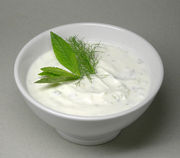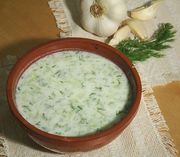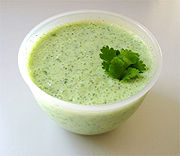Yoghurt

| Nutritional value per 100 g (3.5 oz) | |
|---|---|
| Energy | 257 kJ (61 kcal) |
| Carbohydrates | 4.7 g |
| Sugars | 4.7 g (*) |
| Fat | 3.3 g |
| saturated | 2.1 g |
| monounsaturated | 0.9 g |
| Protein | 3.5 g |
| Vitamin A equiv. | 27 μg (3%) |
| Riboflavin (Vit. B2) | 0.14 mg (9%) |
| Calcium | 121 mg (12%) |
| (*) Lactose content diminishes during storage. Percentages are relative to US recommendations for adults. Source: USDA Nutrient database |
|

Yoghurt or yogurt is a dairy product produced by bacterial fermentation of milk. Fermentation of lactose produces lactic acid, which acts on milk protein to give yoghurt its texture and its characteristic tang. Dairy yoghurt is produced using a culture of Lactobacillus delbrueckii subsp. bulgaricus and Streptococcus salivarius subsp. thermophilus bacteria. The milk is heated to about 80 °C to kill any undesirable bacteria and to change the milk proteins so that they set together rather than form curds. It is then cooled to about 45 °C. The bacteria culture is added, and this temperature is maintained for 4 to 7 hours for fermentation. Soy yoghurt, a non-dairy yoghurt alternative, is made from soy milk.
People have been making and eating yogurt for at least 5,400 years. Today, it is a common food item throughout the world. A nutritious food with unique health benefits, it is rich in protein, calcium, riboflavin, vitamin B6 and vitamin B12.[1]
Contents |
Etymology and spelling
The word is derived from Turkish: yoğurt,[2] and is related to yoğurmak 'to knead' and yoğun "dense" or "thick".[3] The letter ğ was traditionally rendered as "gh" in transliterations of Turkish, which used to be written in a variant of the Arabic alphabet until the introduction of the Latin alphabet in 1928. In older Turkish, the letter denoted a voiced velar fricative /ɣ/, but this sound is elided between back vowels in modern Turkish, in which the word is pronounced [joˈuɾt]. Some eastern dialects retain the consonant in this position, and Turks in the Balkans pronounce the word with a hard /ɡ/.
In Bulgaria, yogurt is called "кисело мляко" (kiselo mlyako), which means "sour milk"; in Serbia and Macedonia, yogurt is also called "кисело млеко" (kiselo mleko), while Serbian and Macedonian yogurt is a thick, milky liquid produced by fermentation of milk.
In English, there are several variations of the spelling of the word. In Australia and New Zealand "yoghurt" prevails.[4][5] In the United Kingdom "yoghurt" and "yogurt" are both current, "yogurt" being more common on product labels, and "yoghourt" is an uncommon alternative.[6] In the United States, "yogurt'" is the usual spelling and "yoghurt" a minor variant. In Canada, "yoghurt" is most common among English speakers, but many brands use "yogourt," since it is correct in both official languages.
Whatever the spelling, the word is usually pronounced with a short o (/ˈjɒɡət/) in the UK, with a long o (/ˈjoʊɡərt/) in North America, Australia and South Africa, and with either a long or short o in New Zealand and Ireland.
History
There is evidence of precultured milk products being produced as food for at least 4,500 years. The earliest yoghurts were probably spontaneously fermented by wild bacteria.
The oldest writings mentioning yogurt are attributed to Pliny the Elder, who remarked that certain nomadic tribes knew how "to thicken the milk into a substance with an agreeable acidity".[7] The use of yoghurt by medieval Turks is recorded in the books Diwan Lughat al-Turk by Mahmud Kashgari and Kutadgu Bilig by Yusuf Has Hajib written in the 11th century.[8][9] Both texts mention the word "yoghurt" in different sections and describe its use by nomadic Turks.[8][9] An early account of a European encounter with yoghurt occurs in French clinical history: Francis I suffered from a severe diarrhoea which no French doctor could cure. His ally Suleiman the Magnificent sent a doctor, who allegedly cured the patient with yoghurt.[10][11] Being grateful, the French king spread around the information about the food which had cured him.
Until the 1900s, yoghurt was a staple in diets of people in the Russian Empire (and especially Central Asia and the Caucasus), Western Asia, South Eastern Europe/Balkans, Central Europe, and India. Stamen Grigorov (1878–1945), a Bulgarian student of medicine in Geneva, first examined the microflora of the Bulgarian yoghurt. In 1905 he described it as consisting of a spherical and a rod-like lactic acid bacteria. In 1907 the rod-like bacteria was called Lactobacillus bulgaricus (now Lactobacillus delbrueckii subsp. bulgaricus). The Russian Nobel laureate biologist Ilya Ilyich Mechnikov, from the Institut Pasteur in Paris, was influenced by Grigorov's work and hypothesised that regular consumption of yoghurt was responsible for the unusually long lifespans of Bulgarian peasants. Believing Lactobacillus to be essential for good health, Mechnikov worked to popularise yoghurt as a foodstuff throughout Europe.
Isaac Carasso industrialized the production of yoghurt. In 1919, Carasso, who was from Ottoman Salonika, started a small yoghurt business in Barcelona and named the business Danone ("little Daniel") after his son. The brand later expanded to the United States under an Americanised version of the name: Dannon.

Yoghurt with added fruit jam was patented in 1933 by the Radlická Mlékárna dairy in Prague.[12] It was introduced to the United States in 1947, by Dannon.
Yoghurt was first introduced to the United States by Armenian immigrants Sarkis and Rose Colombosian, who started "Colombo and Sons Creamery" in Andover, Massachusetts in 1929.[13][14] Colombo Yogurt was originally delivered around New England in a horse-drawn wagon inscribed with the Armenian word "madzoon" which was later changed to "yogurt", the Turkish name of the product, as Turkish was the lingua franca between immigrants of the various Near Eastern ethnicities who were the main consumers at that time. Yoghurt's popularity in the United States was enhanced in the 1950s and 1960s, when it was presented as a health food. By the late 20th century yoghurt had become a common American food item and Colombo Yogurt was sold in 1993 to General Mills, which discontinued the brand in 2010.[15]
Nutritional value and health benefits

Yoghurt is nutritionally rich in protein, calcium, riboflavin, vitamin B6 and vitamin B12.[1] It has nutritional benefits beyond those of milk. People who are moderately lactose-intolerant can consume yoghurt without ill effects, because much of the lactose in the milk precursor is converted to lactic acid by the bacterial culture.[16]
Yoghurt may also be used in preventing antibiotic-associated diarrhea.[17]
Yoghurt is believed to promote good gum health, possibly because of the effect of lactic acid present in yoghurt.[18]
A study published in the International Journal of Obesity (11 January 2005) also found that the consumption of low-fat yoghurt can promote weight loss, especially due to the calcium in the yoghurt.[19]
Varieties and presentation

Dadiah, or Dadih, is a traditional West Sumatran yoghurt made from water buffalo milk. It is fermented in bamboo tubes.
Yoghurt is popular in Nepal, where it is served both as an appetizer and dessert. Locally called dahi (दही), it is a part of the Nepali culture, used in local festivals, marriage ceremonies, parties, religious occasions, family gatherings, and so on. The most famous type of Nepalese yoghurt is called juju dahu, originating from the city of Bhaktapur.
Tarator and Cacık are popular cold soups made from yoghurt, popular during summertime in Albania, Bulgaria, Republic of Macedonia, and Turkey. They are made with ayran, cucumbers, dill, salt, olive oil, and optionally garlic and ground walnuts. Tzatziki, a thick yoghurt-based sauce similar in concoction to tarator, is popular in Greece. Bulgaria typically calls tzatziki "dry tarator".
Rahmjoghurt, a creamy yoghurt with much higher fat content (10%) than most yoghurts offered in English-speaking countries (Rahm is German for "cream"), is available in Germany and other countries.
Cream-top yoghurt is yoghurt made with unhomogenized milk. A layer of cream rises to the top, forming a rich yoghurt cream. Cream-top yoghurt was first made commercially popular in the United States by Brown Cow of Newfield, New York, bucking the trend toward low- and non-fat yoghurts.
Jameed is yoghurt which is salted and dried to preserve it. It is popular in Jordan.
Zabadi is the type of yoghurt made in Egypt, usually from the milk of the Egyptian water buffalo. It is particularly associated with Ramadan fasting, as it is thought to prevent thirst during all-day fasting.[20]
Raita is a yoghurt-based South Asian/Indian condiment, used as a side dish. The yoghurt is seasoned with cilantro (coriander), cumin, mint, cayenne pepper, and other herbs and spices. Vegetables such as cucumber and onions are mixed in, and the mixture is served chilled. Raita has a cooling effect on the palate which makes it a good foil for spicy Indian dishes.
Dudh is a Sindhi-curd, popular in India. People drink dudh along with food at intervals, to help digestion and make food more delicious. In some places dudh is also served with plain rice.
Dahi is a yoghurt of the Indian subcontinent, known for its characteristic taste and consistency. The word dahi seems to be derived from the Sanskrit word dadhi, one of the five elixirs, or panchamrita, often used in Hindu ritual. Dahi also holds cultural symbolism in many homes in the Mithilanchal region of Bihar. It is found in different flavours, two of which are famous: sour yoghurt (tauk doi) and sweet yoghurt (meesti or podi doi). In India, it is often used in cosmetics mixed with turmeric and honey. Sour yoghurt (खट्टी दही) is also used as a hair conditioner by women in many parts of India. Dahi is also known as Thayiru (Malayalam), doi (Assamese, Bengali), dohi (Oriya), perugu (Telugu), Mosaru (Kannada), Thayir (Tamil), or Qәzana a pәәner (Pashto).
Srikhand, a popular dessert in India, is made from drained yoghurt, saffron, cardamom, nutmeg and sugar and sometimes fruits such as mango or pineapple.
Sweetened and flavored yoghurt
To offset its natural sourness, yoghurt can be sold sweetened, flavored or in containers with fruit or fruit jam on the bottom.[21] If the fruit has been stirred into the yoghurt before purchase, it is commonly referred to as Swiss-style.[22] Most yoghurts in North America have added pectin, found naturally in fruit, and/or gelatin to artificially create thickness and creaminess at lower cost. This type of adulterated product is also marketed under the name Swiss-style, although it is unrelated to the way yoghurt is eaten in Switzerland. Some yoghurts, often called "cream line," are made with whole milk which has not been homogenized so the cream rises to the top. Fruit jam is used instead of raw fruit pieces in fruit yoghurts to allow storage for weeks.
Sweeteners such as cane sugar or sucralose – for low-calorie yogurts – are often present in large amounts in commercial yoghurt.
In the USA, sweetened, flavored yoghurt is the most popular type, typically sold in single-serving plastic cups. Typical flavors are vanilla, honey, or fruit such as strawberry, blueberry, blackberry, raspberry, or peach.
Strained yoghurts
Strained yoghurts are types of yoghurt which are strained through a paper or cloth filter, traditionally made of muslin, to remove the whey, giving a much thicker consistency and a distinctive, slightly tangy taste.
Labneh is a strained yoghurt used for sandwiches popular in Arab countries. Olive oil, cucumber slices, olives, and various green herbs may be added. It can be thickened further and rolled into balls, preserved in olive oil, and fermented for a few more weeks. It is sometimes used with onions, meat, and nuts as a stuffing for a variety of pies or kebbeh (كبة) balls.
Some types of strained yoghurts are boiled in open vats first, so that the liquid content is reduced. The popular East Indian dessert, a variation of traditional dahi called mishti dahi, offers a thicker, more custard-like consistency, and is usually sweeter than western yoghurts.
Strained yoghurt is also enjoyed in Greece and is the main component of tzadziki, a well-known accompaniment to gyros and souvlaki pita sandwiches.
Beverages
Ayran or dhalla is a yoghurt-based, salty drink popular in Albania, Bulgaria, Turkey, Azerbaijan, Iran, Republic of Macedonia, Kazakhstan and Kyrgyzstan. It is made by mixing yoghurt with water and (sometimes) salt. The same drink is known as doogh in Iran; tan in Armenia; laban ayran in Syria and Lebanon; shenina in Iraq and Jordan; laban arbil in Iraq; majjiga (Telugu), majjige (Kannada), and moru (Tamil and Malayalam) in South India; lassi in Punjab and all over India. A similar drink, doogh, is popular in the Middle East between Lebanon, Iran and Afghanistan; it differs from ayran by the addition of herbs, usually mint, and is carbonated, commonly with seltzer water.
Lassi is a yoghurt-based beverage originally from the Indian subcontinent that is usually slightly salty or sweet. Lassi is a staple of Punjab. In some parts of the subcontinent, the sweet version may be commercially flavored with rosewater, mango or other fruit juice to create a very different drink. Salty lassi is usually flavored with ground, roasted cumin and red chillies; this salty variation may also use buttermilk, and is interchangeably called ghol (Bengal), mattha (North India),majjiga (Andhra Pradesh),Dahi paani (Odisha), tak (Maharashtra), or chaas (Gujarat). Lassi is also very widely drunk in Pakistan.
Sweetened yoghurt drinks are the usual form in Europe (including the UK) and the US, containing fruit and added sweeteners. These are typically called "drinking / drinkable yoghurt", such as Yop and BioBest Smoothie.
Also available are "yoghurt smoothies", which contain a higher proportion of fruit and are more like smoothies.In Ecuador, yoghurt smoothies flavored with native fruit are served with pandeyuca as a common type of fast food.
See also
- Curd
- Frozen yogurt
- Fermented milk products
- Soy yogurt
Other fermented dairy products
- Kefir
- Matsoni
- Kumis
- Lassi
- Viili
- Smetana
- Shankleesh
References
- ↑ 1.0 1.1 Yale-New Haven Hospital nutrition advisor - Understanding yogurt
- ↑ Merriam-Webster Online - Yogurt entry
- ↑ Ahmet Toprak's article
- ↑ "yoghurt n." The Australian Oxford Dictionary, 2nd edition. Ed. Bruce Moore. Oxford University Press, 2004. Oxford Reference Online. Retrieved 24 May 2007.
- ↑ "yoghurt n." The New Zealand Oxford Dictionary. Tony Deverson. Oxford University Press 2004. Oxford Reference Online. Retrieved 24 May 2007.
- ↑ Peters, Pam (2004). The Cambridge Guide to English Usage. Cambridge: Cambridge University Press, pp. 587-588.
- ↑ The Natural History of Pliny, tr. John Bostock and H.T. Riley, London: Bell, 1856-93, Volume 3, p. 84: "It is a remarkable circumstance, that the barbarous nations which subsist on milk have been for so many ages either ignorant of the merits of cheese, or else have totally disregarded it; and yet they understand how to thicken milk and form therefrom an acrid kind of milk with a pleasant flavour".
- ↑ 8.0 8.1 Toygar, Kamil (1993). Türk Mutfak Kültürü Üzerine Araştırmalar. Türk Halk Kültürünü Araştırma ve Tanıtma Vakfı. p. 29. http://books.google.com/books?id=Ai61AAAAIAAJ&dq=yogurt+kutadgu+divan&q=divan+kutadgu#search_anchor. Retrieved 11 August 2009.
- ↑ 9.0 9.1 Ögel, Bahaeddin (1978). Türk Kültür Tarihine Giriş: Türklerde Yemek Kültürü. Kültür Bakanlığı Yayınları. p. 35. http://books.google.com/books?id=NuvVUlWbikYC&q=yogurt#search_anchor. Retrieved 11 August 2009.
- ↑ Rosenthal, Sylvia Dworsky (1978). Fresh Food. Bookthrift Co.. p. 157. ISBN 978-0876902769. http://books.google.com/books?id=6ZwvAAAAYAAJ. Retrieved 11 August 2009.
- ↑ Coyle, L. Patrick (1982). The World Encyclopedia of Food. Facts On File Inc.. p. 763. ISBN 978-0871964175. http://books.google.com/books?id=iuPJlbBOst8C. Retrieved 11 August 2009.
- ↑ "První ovocný jogurt se narodil u Vltavy" (in Czech: '). 23 July 2002. http://ekonomika.idnes.cz/test.asp?r=test&c=A020723_103620_test_jan. Retrieved 27 April 2009.
- ↑ "The Massachusetts Historical Society | Object of the Month". http://www.masshist.org/objects/2004june.cfm.
- ↑ "Colombo Yogurt - First U.S. Yogurt Brand - Celebrates 75 Years". http://www.thefreelibrary.com/Colombo+Yogurt+-+First+U.S.+Yogurt+Brand+-+Celebrates+75+Years%3B...-a0116520624.
- ↑ "General Mills to discontinue producing Colombo Yogurt". Eagle-Tribune. January 29, 2010. http://www.eagletribune.com/local/x338297210/General-Mills-to-discontinue-producing-Colombo-Yogurt. Retrieved 2010-04-29.
- ↑ Yogurt--an autodigesting source of lactose. J.C. Kolars et al., New England Journal of Medicine, 310:1-3 (1984)
- ↑ Ripudaman S. Beniwal, et al., "A Randomized Trial of Yogurt for Prevention of Antibiotic-Associated Diarrhea", Digestive Diseases and Sciences 48:10:2077-2082 (October, 2003) doi:10.1023/A:1026155328638
- ↑ "Yogurt Good for Gums, Health", dentalblogs.com (February 26, 2008)
- ↑ Dairy augmentation of total and central fat loss in obese subjects
- ↑ Acidified milk in different countries
- ↑ "Faq "Live Cultures In Yogurt"". Askdrsears.Com. http://www.askdrsears.com/faq/fn12.asp. Retrieved 24 September 2009.
- ↑ "Encyclopedia". Web.foodnetwork.com. http://web.foodnetwork.com/food/web/encyclopedia/termdetail/0,7770,1184,00.html. Retrieved 24 September 2009.
External links
- US National Center for Home Food Preservation: Fermenting Yogurt at Home
- Bulgarian yogurt on the Internet
- Acidified milk in different countries
- For a trimmer figure, add an extra helping of gut bacteria
|
||||||||||||||||||||||||
